Setting up a WordPress multisite network allows you to manage multiple websites from a single WordPress installation. This feature is especially useful for blogs, schools, and businesses that need to operate separate sites while maintaining a centralized dashboard.
We have used a multisite network for our own websites and found it very helpful in organizing content for several use cases.
In this guide, we’ll walk you through the steps to properly install and set up a WordPress multisite network, ensuring you get the most out of this feature.
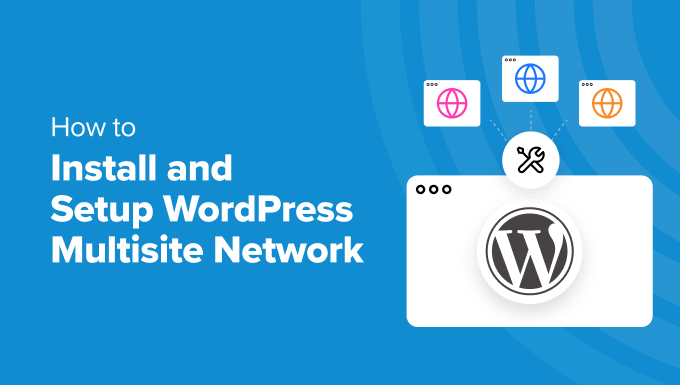
Since this is a comprehensive article, we have added this table of contents for easier navigation. You can use the quick links below to jump to the section you want to learn about:
WordPress Multisite Basics
- What Is WordPress Multisite?
- Pros of Using a WordPress Multisite Network
- Cons of Using a WordPress Multisite Network
- Who Needs a WordPress Multisite Network?
WordPress Multisite Installation and Setup
- Requirements for a WordPress Multisite Network
- Choosing a Domain Structure for Your Multisite Network
- Setting Up Wildcard Subdomains
- Setting Up Custom Domain for WordPress Multisite
- Enabling WordPress Multisite Network Feature
- Setting Up Your WordPress Multisite Network
WordPress Multisite Configuration Settings
- Configuring Network Settings
- Opening Your Multisite Network for Registrations
- New Site Settings
- Upload Settings for Your Multisite Network
- Plugin Menu Settings
Setting Up Default Content, Theme, and Plugins
- Adding New Sites to Your WordPress Multisite Network
- Adding Themes and Plugins to Your Multisite Network
- Adding Default Content to New Sites
Troubleshooting and FAQs
What Is WordPress Multisite Network?
A WordPress multisite network allows you to run and manage multiple WordPress blogs or websites from a single WordPress installation.
It enables you to create new sites instantly and manage them using the same username and password. You can even allow other users to sign up and create their blogs or websites on your domain.
The WordPress multisite network comes with advanced settings that you can use to customize each website/blog on your network.
Pros of Using a WordPress Multisite Network
In many situations, a WordPress multisite network can be more useful than managing multiple standalone WordPress sites. Here are some of the advantages of using a WordPress multisite network:
- As the network administrator, you can easily manage multiple sites from a single dashboard.
- Each site on the network can have its admin users. The site admins will have the capability to manage only their website.
- You can install plugins/themes and activate them for multiple sites with one download.
- A multisite network also makes it easier for you to manage updates. You only need to update your WordPress, plugins, or themes on one “master” install.
Cons of Using a WordPress Multisite Network
Creating a WordPress multisite network is not always helpful for managing multiple sites.
Here are some of the disadvantages that you should keep in mind before setting up a multisite network.
- All sites on the network share the same resources, so when your network is down, all other sites also go down.
- It’s difficult for beginner-level users to manage traffic and server resources. If one of your websites gets unexpected traffic, it will affect all other websites on the network.
- If one website gets hacked, all sites on your network get hacked. For more information, see our guide on WordPress multisite security tips.
- Some WordPress plugins may not work well on a multisite network.
- All web hosting providers do not adequately support the WordPress multisite network, which limits your options. We will discuss this further later in the article.
Who Needs a WordPress Multisite Network?
Just because you manage multiple WordPress websites does not mean you need to start using a multisite network.
There are third-party tools to manage multiple WordPress sites from a single dashboard. Tools like InfiniteWP or MainWP make it easier to maintain multiple WordPress sites under one roof without switching back and forth from one site to another.
Here are some scenarios when creating a multisite network makes sense:
- A magazine website with different sections managed by separate teams
- A business website with sub-sites for different locations and branches
- Government or non-profit websites using WordPress multisite for different departments, locations, and regions
- Your network of blogs running on multiple subdomains
- Schools and colleges using multisite for different departments and blogs or letting students create their websites on school servers
Requirements for a WordPress Multisite Network
All websites on a WordPress multisite network share the same server resources. This means that the most important thing you will need is good WordPress hosting.
If you plan on having just a couple of websites with low traffic, shared hosting is probably a good option.
However, due to the nature of a multisite network, you will typically need VPS hosting or a dedicated server as your sites grow.
We recommend Bluehost because they offer shared hosting and VPS/Dedicated servers. They are also one of the official WordPress hosting partners.
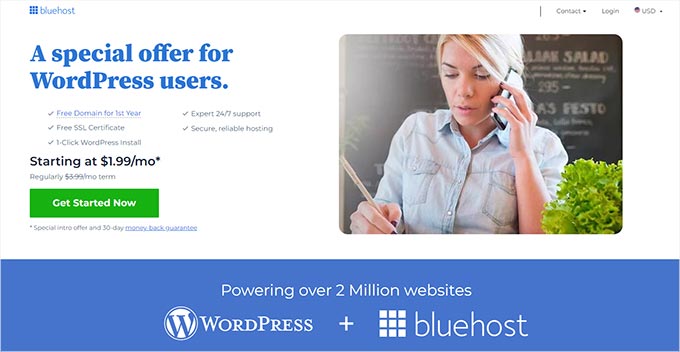
If you’re looking for an alternative, then SiteGround and WP Engine also provide excellent service for WordPress multisite networks.
Apart from web hosting, you will need the basic knowledge of installing WordPress and editing files using FTP.
Choosing a Domain Structure for your Multisite Network
On a WordPress multisite network, you can add new sites using either subdomains or sub-directories.
Example of a subdomain:
http://site1.example.com
Example of sub-directory:
http://example.com/site1/
If you choose subdomains, then you’ll have to configure wildcard subdomains on your server. We will show you how to do that in the next step.
On the other hand, if you choose sub-directories or path-based URLs for sites on your network, you can skip the next step.
Setting Up Wildcard Subdomains
Wildcard subdomains create a placeholder subdomain under your domain name. This placeholder subdomain can then be used to map subdomains that you haven’t already defined.
This setting enables WordPress multisite to create new sites using their own subdomains.
If you decide to use subdomains for websites on your multisite network, then you will need to set up wildcard subdomains.
We will show you how to do that on Bluehost. However, the basic process is the same for all hosting providers.
First, you need to log in to your WordPress hosting account’s dashboard. Locate your site under Websites and click on the ‘Settings’ button.
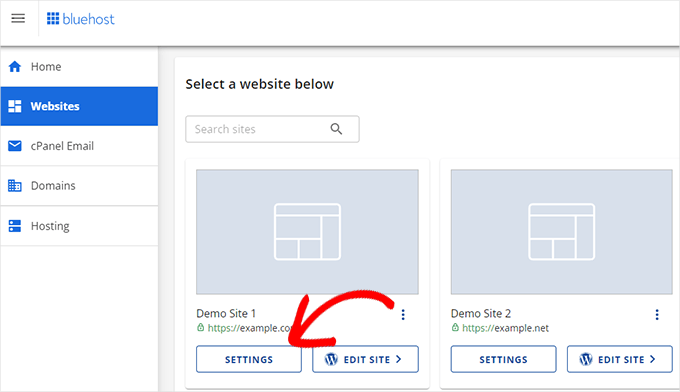
This will open your site’s Settings page, where you need to switch to the ‘Advanced’ tab.
From there, scroll down to the cPanel section and click the ‘Manage’ button.
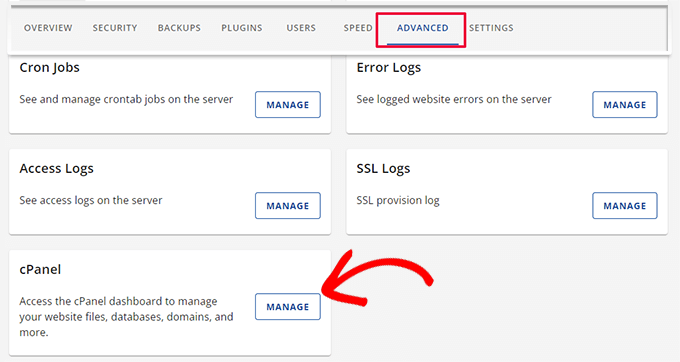
This will launch the cPanel dashboard.
Now, scroll down to the Domains section and click ‘Domains’.
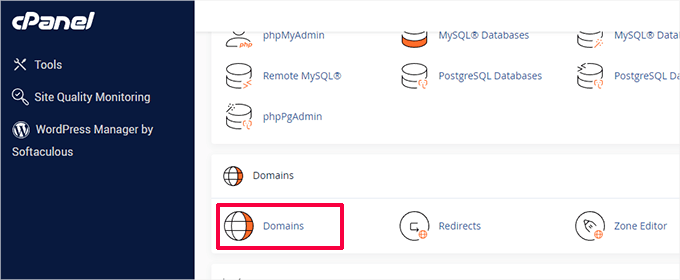
It will then show you a list of domains and subdomains on your hosting account.
You need to click the ‘Create A New Domain’ button to continue.
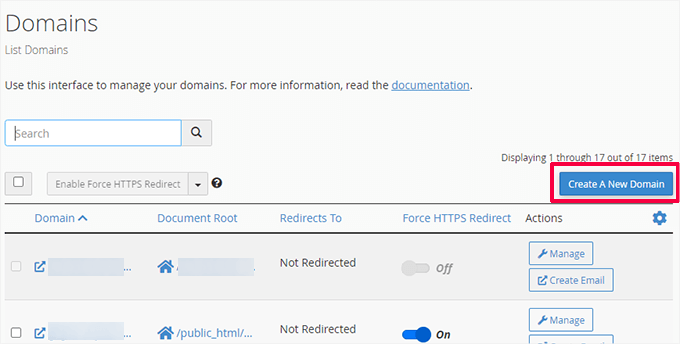
On the next screen, you need to add a wildcard subdomain under the Domain field.
A wildcard subdomain contains an asterisk sign followed by a dot and your domain name. Like this:
*.example.com
Don’t forget to replace example.com with your domain name.
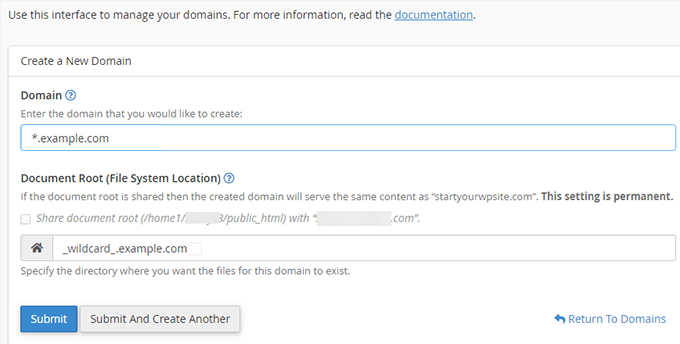
The document root field will be automatically filled to match the wildcard.
Just click the ‘Submit’ button to save your domain settings.
Your hosting account is now ready to support WordPress multisite with subdomains.
Setting Up Custom Domains for Each Site
WordPress multisite also allows you to set different domains for each website in your multisite network.
To set up custom domains, you will need to use the domain mapping feature and update nameserver records in your domain registrar account.
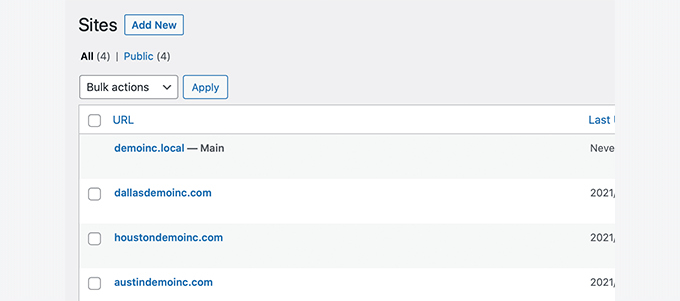
We have created a detailed step-by-step guide on how to create WordPress multisite with different domains with the setup instructions.
Enabling the WordPress Multisite Network Feature
The multisite network feature is built into each WordPress installation. To use it, you simply install and set up WordPress as you normally would.
After that, you just need to enable the multisite feature. You can also enable the multisite feature on any existing WordPress site.
Before you enable multisite, don’t forget to create a complete backup of your WordPress site.
Then, connect to your site using an FTP client or cPanel file manager, and open the wp-config.php file for editing.
You need to add the following code to your wp-config.php file just before the /* That’s all, stop editing! Happy publishing. */ line:
/* Multisite */
define( 'WP_ALLOW_MULTISITE', true );
Once that’s done, you can save and upload your wp-config.php file to the server.
This code simply enables the multisite feature on your WordPress site. Once enabled, you will still need to set up the multisite network.
Setting Up Your WordPress Multisite Network
Now that you have successfully enabled the multisite network feature on your WordPress site, it is time to set up the network.
If you are setting up a multisite network on an existing WordPress website, then you will need to deactivate all plugins on your site.
Simply visit the Plugins » Installed Plugins page and select all plugins. Then, select ‘Deactivate’ from the ‘Bulk Actions’ dropdown menu and click on the ‘Apply’ button.
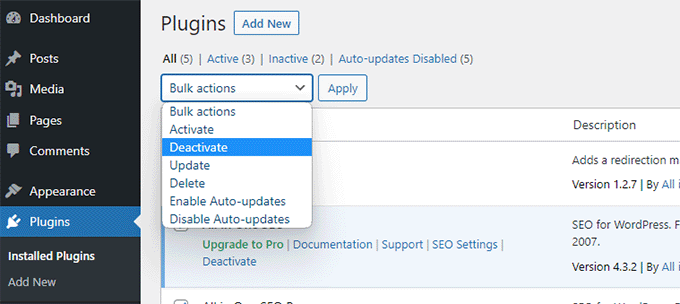
You can now head over to the Tools » Network Setup page.
Here, you can configure your multisite network.
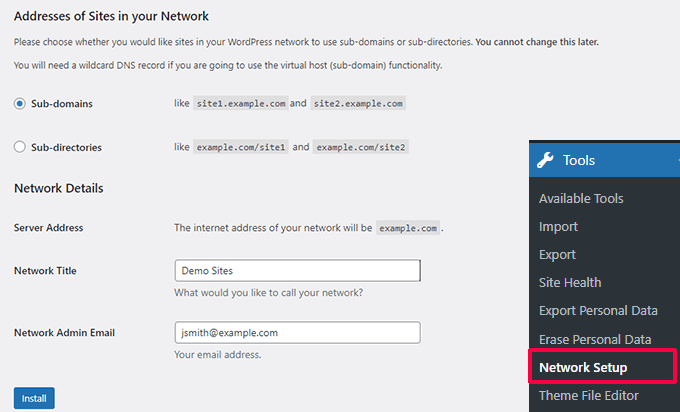
On the network setup screen, you will notice that you need Apache’s mod_rewrite module installed on your server. This module is installed and enabled on all the best WordPress hosting providers.
Next, you need to tell WordPress what domain structure you will use for sites in your network, e.g., Subdomains or Subdirectories.
After that, you will need to provide a title for your network and ensure the email address in the ‘Network Admin Email’ field is correct.
Click on the ‘Install’ button to continue.
WordPress will now show you some code to add to your wp-config.php and .htaccess files, respectively.
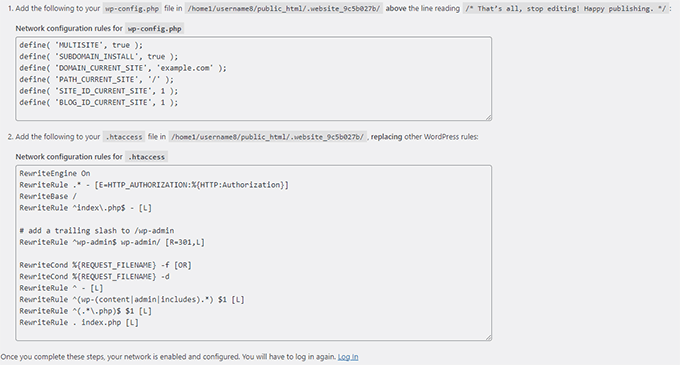
You can use an FTP client or the File Manager in the cPanel to copy and paste the code.
First, edit the wp-config.php file and paste the code just below the line you added in the earlier step.
Secondly, you need to edit the .htaccess file and replace the existing WordPress rules in your .htaccess with the WordPress multisite code you copied.
Don’t forget to save your changes and reupload the edited files back to your server.
Once finished, you will need to re-login to your WordPress site to access the multisite network.
Configuring Network Settings
Now that you have set up the multisite network, it is time to configure its network settings.
Start by logging in to your WordPress website admin area.
After that, you need to switch to the ‘Network Dashboard’ settings to change network settings, add new sites, and configure other settings.
When you take your mouse over to the ‘My Sites’ menu in the admin toolbar, a flydown popup will appear. Click on the Network Admin » Dashboard.
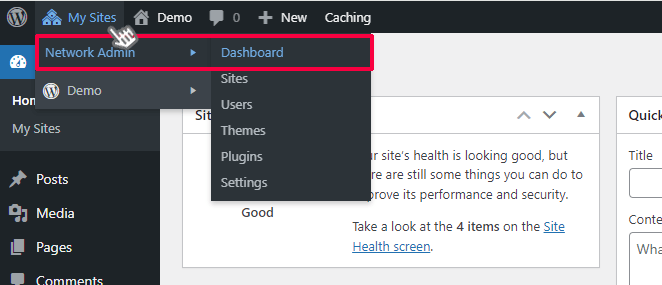
This will take you to the multisite network dashboard. You will notice that there are new menu items to manage your multisite network.
You will also see a ‘Right Now’ dashboard widget that allows you to create a new site and add new users.
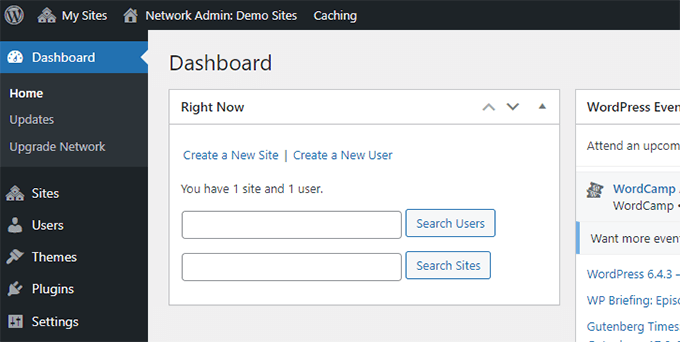
To configure network settings, click on the ‘Settings’ link in the admin sidebar.
The first option on the network settings page is to set your site title and admin email address. These fields will be filled automatically with the network title and admin email you entered during setup.
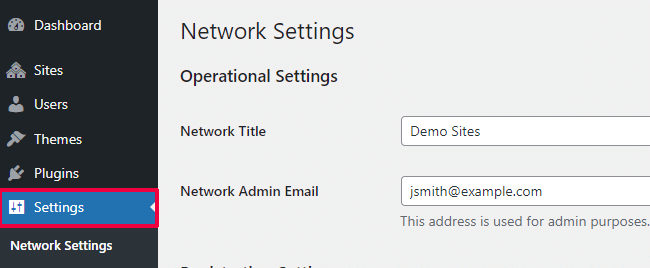
Opening Your Multisite Network for Registrations
The ‘Registration Settings’ section on the network settings page is probably the most important setting in your entire network setup.
By default, both user and site registrations are disabled on the network.
You can choose to open your site to user registration, allow only existing users to create new sites, or allow both user and site registration.
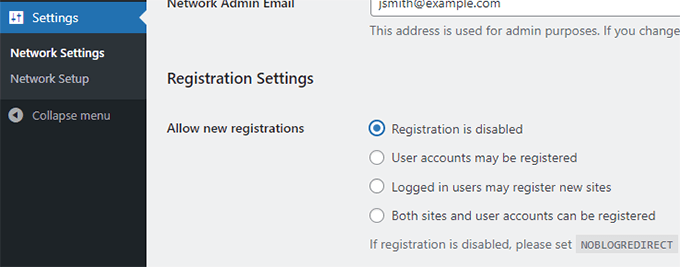
If you are opening your multisite network to registration, then you can check the box next to the ‘Registration Notification’ option.
This will allow you to receive email notifications every time a new user or site is registered.
If you want to allow individual site administrators to add new users to their sites, check the box next to the ‘Add New Users’ option.
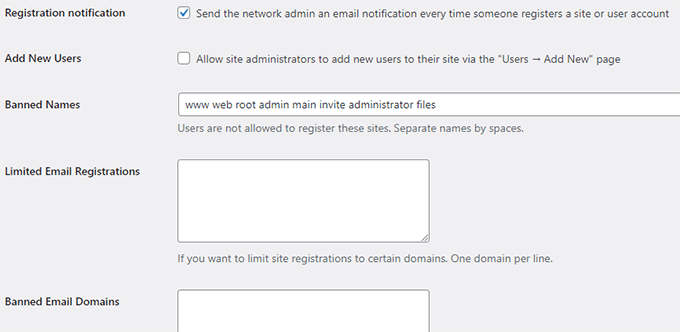
The limited Email Registration option allows you to limit site or user registration to email addresses from specific domains.
This is particularly useful if you want to allow only people from your organization to register and create users or sites.
Similarly, you can also ban certain domains from registration.
New Site Settings
The ‘New Site Settings’ section allows you to configure default options for new sites created on your multisite network.
You can modify the welcome emails and the contents of the first default post, page, and comment in these settings.
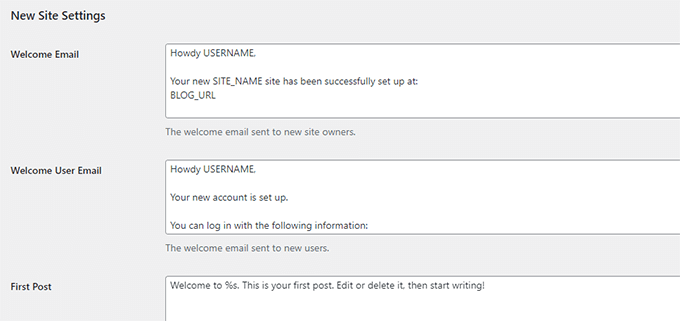
As a network administrator, you can change these settings anytime.
Upload Settings for Your Multisite Network
It is important to monitor your server resources’ usage. Under the ‘Upload Settings’ section, you can limit the total amount of space a site can use for uploads.
The default value is 100 MB, which is probably enough for at least 100 photo uploads. You can increase or decrease this space depending on your disk space.
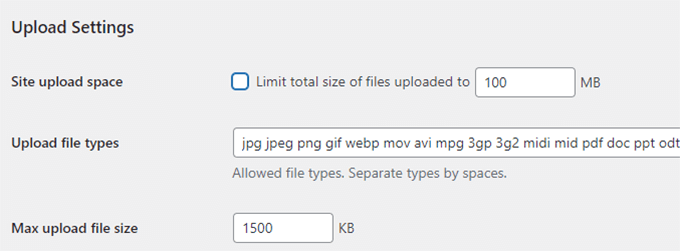
The default upload file types are images, audio, video, and PDF files. You can add additional file types, like doc, docx, odt, and so on.
Afterward, you can choose a file size limit so that users can’t upload insanely large files to the server.
Plugin Menu Settings
Next, you can jump to the Menu Settings. It will allow you to enable the administrative menu for the plugins section on your network sites.

Enabling this will show the Plugins menu to respective site admins. They can activate or deactivate a plugin on their sites, but they cannot install new plugins.
Once you are satisfied with all the configuration settings, go ahead and click the ‘Save Changes’ button.
Adding New Sites to Your WordPress Multisite Network
To add a new site to your WordPress multisite network, simply click on ‘Sites’ under the My Sites » Network Admin menu in the admin toolbar.
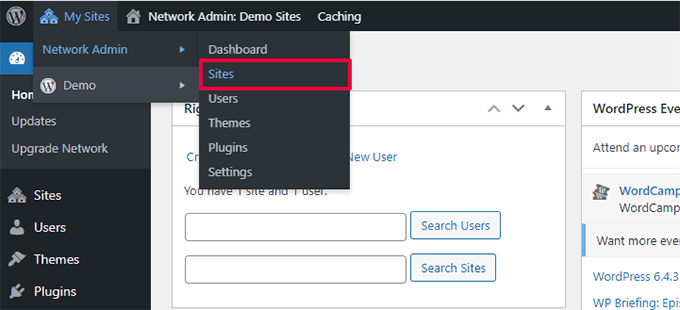
This will show you a list of sites on your current multisite installation. By default, your primary site is listed as the only site in your WordPress multisite network.
To add a new site, click the ‘Add New’ button at the top.
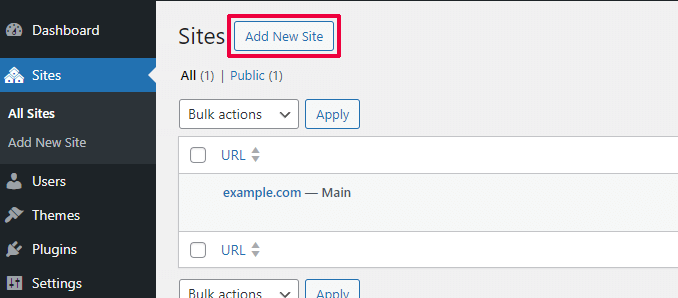
On the ‘Add New Site’ page, provide the site’s address. You don’t need to type the full address, just the part you want to use as the subdomain or sub-directory.
Next, you add a site title and enter the site admin’s email address.
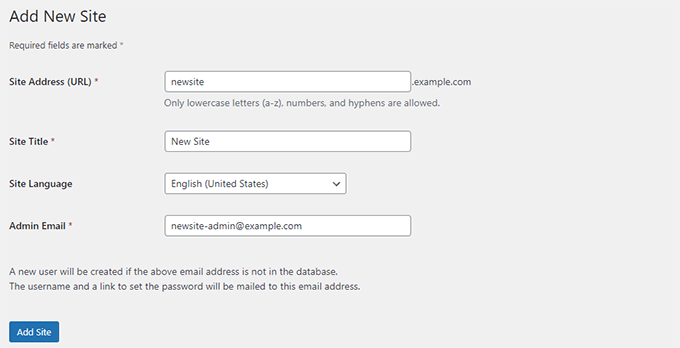
You can add an admin email address other than the one that you are currently using to manage your multisite network.
If another user does not currently use that email address, then WordPress will create a new user and send the username and password to the email address you enter.
Once you are done, simply click on the ‘Add Site’ button.
A new site will be added to your WordPress multisite network. You will also receive a new site registration email as the network admin.
If you create a new user, that user will receive an email with instructions for setting the password and logging in.
Adding Themes and Plugins to Your Multisite Network
By default, individual site administrators in a multisite network cannot install themes and plugins on their own.
As the network admin, you can install the respective plugins and themes so they are available for all sites on your network.
Installing Themes for Your Multisite Network
To add themes, go to the My Sites » Network Admin » Themes page.
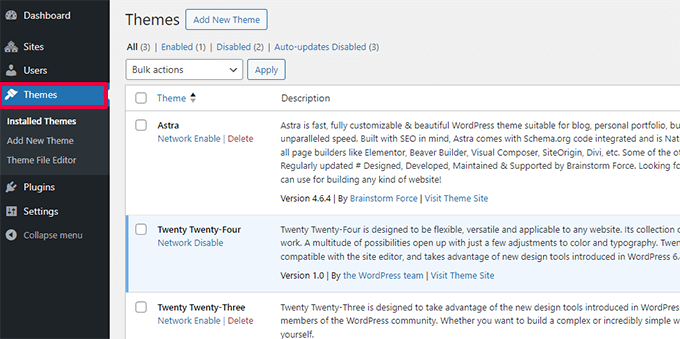
On this page, you will see a list of themes that are currently installed on your WordPress multisite.
You can make a theme available to other sites by clicking on the ‘Network Enable’ option under that theme.
You can also disable a theme by clicking on the ‘Network Disable’ link under it. Note that the Network Disable option will only appear when the theme is enabled.
To add a new theme, click the ‘Add New’ button at the top of your screen and install a WordPress theme as you would normally do.
Once the new theme is installed, you will be able to make it available to other sites on your network with the ‘Network Enable’ option.
If you need recommendations on which themes to make available to your network, here are our picks of the best WordPress themes that you can use:
- Best free WordPress blog themes
- Best free WordPress photography themes
- Best WordPress multi-purpose themes
Setting a Default Theme for Your Multisite Network
Even if you have added a couple of themes, WordPress will still activate the default WordPress theme for each new site.
If you want to make another theme the default for new sites, then you need to add the following code to your wp-config.php file:
// Setting default theme for new sites
define( 'WP_DEFAULT_THEME', 'your-theme' );
Replace your-theme with the name of your theme. You will need to use the name of the theme’s folder, which you can find by looking at the /wp-content/themes/ folder using FTP or File Manager.
Installing Plugins for Your Multisite Network
Similarly, you can visit the My Sites » Network Admin » Plugins page to install plugins and click on the ‘Network Activate’ link below each plugin to activate it on your multisite network.
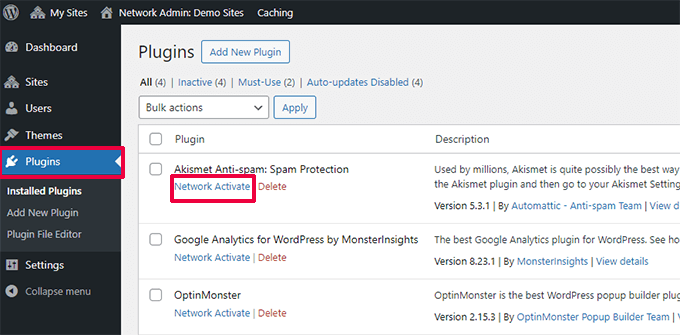
Here are a few essential WordPress plugins that we recommend for every website:
- WPForms – It is the best WordPress contact form plugin that allows you to quickly create beautiful forms using a simple drag-and-drop form builder.
- All in One SEO – It is the most comprehensive WordPress SEO plugin on the market that will help you get more visitors from search engines.
- MonsterInsights – The best Google Analytics solution for WordPress that lets you view traffic data and other helpful reports in your WordPress dashboard.
- SeedProd – Site admins may want to show a coming soon page as they work on their sites. SeedProd allows them to add beautiful coming soon and maintenance mode landing pages.
- WP Mail SMTP – WP Mail SMTP helps you fix the WordPress not sending email issue by using an SMTP server to send crucial multisite registration and notification emails.
For more plugin recommendations, see our list of the essential WordPress plugins for all websites.
Note: If you previously enabled the Plugins Menu option for site admins in the ‘Network Settings,’ then site admins can activate or deactivate installed plugins on their own. However, they cannot delete or install a new plugin on their own.
Adding Default Content to Multisite Sites
By default, WordPress allows you to add and edit some default content for each site on your multisite network. You can go to Settings » Network Settings page and add this content in the ‘New site settings’ section.
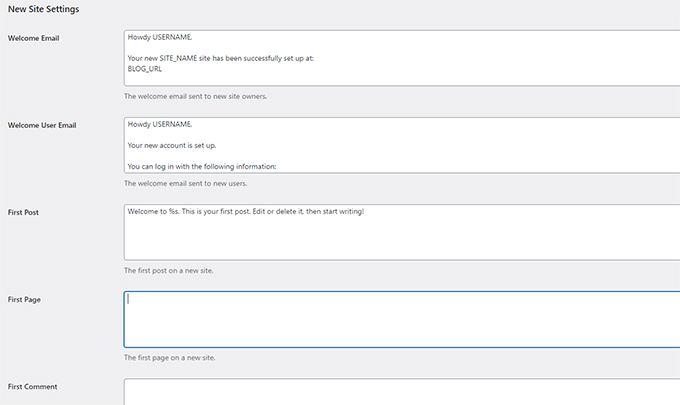
You can edit the content for the default post, page, and comment. We recommend replacing the default content with something more useful for your site admins.
But what if you wanted additional default content to be added to each new site?
By default, WordPress does not give you an option to create additional default content for new sites. If you want to do that, then you will need to add custom code to your WordPress multisite.
In this example, we are going to add a new default page to be created for each new site. You can add this code to your main site’s functions.php file or by using the WPCode plugin on your main site:
add_action('wpmu_new_blog', 'wpb_create_my_pages', 10, 2);
function wpb_create_my_pages($blog_id, $user_id){
switch_to_blog($blog_id);
// create a new page
$page_id = wp_insert_post(array(
'post_title' => 'About',
'post_name' => 'about',
'post_content' => 'This is an about page. You can use it to introduce yourself to your readers or you can simply delete it.',
'post_status' => 'publish',
'post_author' => $user_id, // or "1" (super-admin?)
'post_type' => 'page',
'menu_order' => 1,
'comment_status' => 'closed',
'ping_status' => 'closed',
));
restore_current_blog();
}
You can use the same code with little modifications to create default posts for new sites. Check out the following code:
add_action('wpmu_new_blog', 'wpb_create_my_pages', 10, 2);
function wpb_create_my_pages($blog_id, $user_id){
switch_to_blog($blog_id);
// create a new page
$page_id = wp_insert_post(array(
'post_title' => 'A sample blog post',
'post_name' => 'sample-blog-post',
'post_content' => 'This is just another sample blog post. Feel free to delete it.',
'post_status' => 'publish',
'post_author' => $user_id, // or "1" (super-admin?)
'post_type' => 'post',
));
restore_current_blog();
}
Troubleshooting WordPress Multisite Issues
The most common issues with WordPress multisite network setup are incorrect configuration of wildcard subdomains and domain mapping issues. Before setting up multisite, make sure that your web host supports wildcard subdomains.
The following are some other common issues and their quick fixes.
Fixing Login Issues on Multisite Installs
A common issue is that when using WordPress multisite with sub-directories, some users are unable to log in to the admin area of their sites after they add the required code in the wp-config.php file.
To fix this, locate the following line in the wp-config.php file:
define('SUBDOMAIN_INSTALL', false);
Now, simply replace it with the following line:
define('SUBDOMAIN_INSTALL', 'false');
Find Unconfirmed Users
Another issue you may encounter is not being able to find users who registered on your network but didn’t get the activation email.
To fix this issue, see our guide on how to find pending unconfirmed users in WordPress.
Exporting a Site From Multisite to Its Own WordPress Install
Later, you or another site owner may want to export a site from multisite to a separate WordPress install. This can be easily done. For step-by-step instructions, see our guide on how to move a site from WordPress multisite to single install.
You may also want to bookmark our ultimate guide to common WordPress errors and how to fix them. This will save you a lot of time fixing the most common WordPress issues quickly.
FAQs About WordPress Multisite Network
Many of our users have asked us plenty of questions about WordPress multisite network and how to use it more efficiently. The following are the most frequently asked questions that we have answered.
1. Would I be able to better manage my sites with a multisite network?
To be honest, the answer really depends on your usage scenario.
For example, if your websites are not related to each other, then you would be better off with a multiple site management tool like InifiteWP.
However, if you manage multiple sites for a restaurant chain, university, or online magazine, then WordPress multisite will be more efficient.
2. Does WordPress multisite make my websites load faster?
Once again, it depends on several factors. Better WordPress hosting with plenty of server resources will allow multisite to be faster, but then again, with these resources, individual WordPress sites will also run faster.
However, on a shared hosting account, traffic spikes will increase memory usage and slow down all websites on the multisite network at the same time. To improve multisite speed, see our guide on WordPress performance and speed optimization.
3. Can I add an online store to a WordPress Multisite Website?
Yes, you can add an online store in the WordPress multisite network. Most likely, you will be using an eCommerce plugin like WooCommerce for that, which is compatible with WordPress multisite.
4. Can I install ‘x plugin’ on my WordPress multisite?
Some WordPress plugins may not be compatible with WordPress multisite. Normally, plugin authors mention it on the plugin’s website, and you can avoid installing a plugin that may not work on a multisite setup. However, if it is not mentioned, then it is safe to assume that it is multisite compatible.
5. How do I share user logins and roles across the multisite network?
By default, a user who is registered on one site cannot register or be added to another site on the same network. That’s because they are already registered in the shared WordPress database. However, they don’t have any user role privileges on other sites.
You can use third-party plugins like WP Multisite User Sync to sync users across the network. However, you need to be careful, as you may end up giving someone admin privileges to a site.
We hope this article helped you learn how to install and set up a WordPress multisite network. You may also want to see our tutorial on creating a WordPress multisite with different domains or our expert pick of the best WordPress multisite plugins.
If you liked this article, then please subscribe to our YouTube Channel for WordPress video tutorials. You can also find us on Twitter and Facebook.





Joseph
Subdirectory for creating new site is missing. only sub domain
Colleen
Hi, I am new to WP and learning in baby steps. My husband and I have several websites whose website builder went out of business. So we have a host and domain names. I opened up a wordpress account and am in the process of transferring over one of my sites.
But, since I read your article above, it looks like a multi-site network might not be best, but I cannot find any info online on how to open up a new and different WP account with a different website. and I would have to do this for each of our five websites. They are all different kinds of sites that do not relate to each other at all.
what do you suggest? thank you
WPBeginner Support
Hi Colleen,
You can sign up for a hosting provider and host multiple websites on the same hosting account. You can also add multiple domains and install multiple instances of WordPress for each website under the same hosting account.
However, if your websites get more than you should consider VPS hosting or managed WordPress hosting.
Admin
Joao Cerca
After following all the instructions on this post, I always get the same problem with the themes. I have a theme for the main website and it works perfect, even the theme selector area is fine.
However, the 2nd and the other websites created after are completely void of any style, also the theme selector has nothing. I cannot find any proper solution for my problem.
WPBeginner Support
Hi Joao Cerca,
You can go to Network Admin > Themes page to install themes for other sites on your network. You will need to click on the ‘Enable Network’ button below that theme. After that you can go to your other sites and activate theme you want to use on those sites.
Admin
Dese Abebe
When i create multisite on hostgator, i got a warning message to remove www. But i want my websites to look like
www.example.com/multisites.So how can i do like this? Please wpbeginer give me a solution!
WPBeginner Support
Hi Dese,
You can install it on HostGator.
Admin
Max Dai
I deactivated all plugins at once and suddenly my site stopped working. Browser says “redirected you too many times”. How to solve this?
Ryan
The problem I am having is that after I create a new subdomain site2.example.com so that I can effectively “add new site” in wordpress, I am unsure how to delete the old “site1.example.com” and point the url to subdomain 2. The second subdomain doesn’t show up in my file structure in my cpanel. So how does one simply “export content from first site, import it into new site…and then change web addresses over?” There seems to be no easy answer online anywhere.
Jacob Conway
I need to allow users to sign up for a site using multi site but also need my main site duplicated for the user. Can this be done? If so, how?
Jeanette Folkes
Great article and super easy steps to follow. When I create the multisite, all I’m getting is Index of / and a directory listing, which at the moment is just cgi-bin. Originally I was getting a site not found error and added FollowSymLinks to my .htaccess file and now just a directory listing.
Any suggestions how to fix that? Using subdomains as it was an existing site. have updated the wp-config file and .htaccess. Hosting confirms they meet all requirements (mod_rewrite, etc). Just not sure where to go from here. Feels like the site is not finding the Wordpress installation.
Thanks so much for any suggestions!
Cristiano
Hi,
Your post is VERY interesting and well written. Thanks for that.
Then, my question: Can a multisite network be installed itself in a subdomain?
(I would use subdirectories for the individual sites of the network)
Thanks a lot!
WPBeginner Support
Hi Cristiano,
Yes, you can install a multisite network on a Subdomain and use subdirectories for each site on the network.
Admin
Cristiano
Hi,
Thanks for your reply.
I just tried and it works perfectly.
Once more congratulations for this article.
BR
Cristiano.
Amir hanif
Is there an option to implement woocomerce in this multisite thing, the meaning of this is that if one subdomain site sells an item it will show the order on the subdomain site as wel as one the admin site wich can make other sites etcc.
Its useful to know if that part would work so there can be one place where all the orders of the subdomains collect
Sonia Woolf
All my dashboards go back to the original site – and any changes are done on the original site…I can’t see where I went wrong.
Taylor
I am having this same issue. Have you found the solution yet?
Harsh Nagda
Hi,
After modifiying wp-config.php file and .htacces file i am getting this error.
“One or more database tables are unavailable. The database may need to be repaired.”
What can be done?
Thanks.
Laura
Hi,
I noticed at least a couple of others running into this same issue, but no answers: When I try to view my newly-created additional sites, I get a 403 error – no permission to view. What did I miss? Dashboards all work fine, I just can’t actually view the sites themselves.
Wouter
I would like to categorize my self hosted blogs (individual domains) and then let my blog writer only access blogs from a certain category so he can maintain them with fresh content. How do I do that? For categorization I already found this plugin:
So now only to be able to give users permission to access blogs form a category.
Ankit Dhadwal
I have created a subdomain but its path is not public_html/ ……
When i have created a sub domain the steps that I followed were
1. Gave name to my new subdomain
2. Then clicked on create button.
Automatically a path was created blog.xyz.com
I have check this in your screenshot and on youtube also but everywhere the path is public_html/
but why my path is different???
Please help me in this and also can you help me installing Wordpress in my subdomain.
WPBeginner Support
Hey Ankit,
It is OK, your path can be different depending on how your web hosting company has configured their servers.
Admin
Vishnu Goyal
Should one use sub-domains or sub-directories? What are the pros and cons of both? Please add a small guidance on this issue in this article.
Thanks!
smart kutter
hello, thanks so much for your article has really help but how can i access the wp-admin of new domain on my multisite?.. is telling me Access Forbidden with this error massage:
Access forbidden!
You don’t have permission to access the requested directory. There is either no index document or the directory is read-protected.
If you think this is a server error, please contact the webmaster.
Error 403
localhost
Apache/2.4.23 (Win32) OpenSSL/1.0.2h PHP/7.0.
Erik
Is there any way to have a set theme already created like content, design, etc. and when a new user signs up and creates an new site via registering that it automatically has that pre-built website page for them?
Sara
Hey, thanks for this description.
Can you also name me a gallerie plugin which works on a multisite with up to four websites?
I need something where I create one gallery and use the pictures on every website to not upload them several times.
Appreciate your help!
Sara
Ameer Hamza
sir i can’t deactivate the plugins is there any solutions to do that?
WPBeginner Support
Hey Ameer,
See our guide on how to deactivate plugins when not able to access WordPress admin.
Admin
rohit
hi,
i want to know that where to upload existing themes. actually i have 10 single sites so i want to implement one multisites. all the single site have same theme but but they have different css. so how to include all 10 themes in multisites for single site.
Wenda
OK. First. THANK YOU! it’s amazing that you published this full and comprehensive post about creating the wordpress multi-users. I am having a problem finding the one step that shows whether I want a subdomain versus subdirectory. Maybe it’s because I cant find the apache installation so I can’t see find the mod_rewrite. I haven’t gotten past that part of your tutorial (besides enabling the registration) I suppose I can live with the directory.. but I’d REALLY REALLY like the subdomain! I setup the wildcard, but I don’t have a “tools” option in the network dashboard and no option to choose between subdomain or directory.
I setup the wildcard, but I don’t have a “tools” option in the network dashboard and no option to choose between subdomain or directory.
Hamza
Hi,
is this possible in wordpress that we can post on 1 website can also be posted on other wordpress website?
note: not with iframe.
thanks
SAMITH TON
Hi,
I just set up multiple WordPress websites following your guides but I need to use domain sub directory in multisite network. However, after completing the step-by-step guide, it shows only Subdomains for adding new sites in the Network Admin. How can we have another way to add wildcard subdirectory instead of subdomains? Please provide me the tutorials to follow.
Thanks so much for helpful articles posted!
Best,
SAMITH TON
Tony
I require my users to login to the site to use the services. When I convert my site to multi-site, will my users still be able to go to the base url (www.myblogsite.net) to login – or will they have to go to the subdomain/subdirectory of the site to login in? In other words, if they go to the base url (which requires the username and password) does WordPress recognize each individual user – and then redirect them to the appropriate subdomain/subdirectory that they belong to?
Mayuna
Thank you for sharing this great article.
I succeed to setup all steps above, but next, how could I access to site1 dashboard?
‘site1.domain.com/wp-admin’ is not found.
Could you give me an advise..?
Edmond
Dear WP Begginer
I created Multisite. When i create sub domain it allows it but the problem i cant access the subdomain site. When i visit pointtheme.edmoblogs.com/wp-admin/ i get an error. I asked my web hosting if i configured wild-card well and they checked they say NO problem on their side.
When first i install the multisite, It was installed in a sub-directory. I accessed wp-config.php to change define(‘SUBDOMAIN_INSTALL’, ‘false’);” to define(‘SUBDOMAIN_INSTALL’, ‘TRUE’);”.
Should i chance the .HTACCESS or what can i do?
Jared latigo
Not sure if you got this resolved but you can’t swap it once you setup the network. It is how it is setup in the first place. I’m not sure why but I’ve found that to be the case for me. You will have to reinstall the network unfortunately. Hope that helps.
Chris
I followed the basic instructions for adding the
/* Multisite */
define( ‘WP_ALLOW_MULTISITE’ , true);
to the wp-config.php file in my server through FTP but even after I save the changes and refresh my wordpress site I do not see a NETWORK SETUP option in my TOOLs section.
I have already deactivated all of my plugins to allow for this and given ample time to let changes take effect.
Thoughts on why this very basic first step hasn’t worked? The php changes were saved in the files on the server…confirmed
Manel
Me too.
Please, we need a solution
Angie
Did anyone find a resolution to this? I am having the same problem and am not sure what to try.
Thank you!
Joao Cerca
Check the quotas on the syntax. Can be that while copying the syntax, the system is putting ` instead of ‘.
It happened to me once.
R. Arms
Thank You!!! I’ve been beating my head against the proverbial wall trying to figure out why I couldn’t get this to work. I went so far as to uninstall and reinstall everything trying to get this to work.
I never noticed that they weren’t plain quotes.
Ahmad
Make sure you paste the code you are supposed to paste in wp-config.php above the line that reads [ /* That’s all, stop editing! Happy blogging. */ ] in wp-config.php
Tyler
After following this guide on a fresh wordpress installation, the addon sites do not load. I am getting a 404 error when i try to access the addon sites website/dashboard. The main website seems to be working just fine. Any ideas?
Carrie
I already have a working installation of wordpress (.org). I used for a class project.
What the class did not teach was…now I have a client who needs a site built – it’s a new site they never had one. So how do I do this and where do I go? I had to use MS webmatrix for the project. I am totally lost and confused. Do you have tutorials on how to do this? I cannot find this anywhere?
Do you have these tutorials and if not can you make them…
Thank you…I’m totally frustrated
WPBeginner Support
Please take a look at how to start a WordPress blog. For further help refer to our Start Here page.
Admin
Dan Snyder
I want to build a site for a store chain that has multiple stores. If I use multisite and make a site for each store can I get the main theme to copy directly to each store with it’s graphics, so all of them look alike without configuring each store? Can I use WooCommerce and get it to show the inventory of each store, which will be different than other stores?
thanks,
Dan
Shetty
I migrated two of my sites to siteground under single plan. They have used multi site install those. The main site is working correctly, but i am facing issues with the second site
It looks like i have an issue with the Multisite installation.
For instance, when i tried to access the Tools ->Network I get the following message
Warning: Please deactivate your plugins before enabling the Network feature.
How do i enable the network, do i loose the data for the second site ?
I also have separate database for both sites. users accounts are also different
Is it correct ?
Jaco Smith
Good day, I am in urgent need of some assistance! I have one site in my WordPress Multisite Network, but I want to change that to a single install of Wordpress!
Please urgently assist!
WPBeginner Support
See our guide on how to move a site from WordPress multisite to single install.
Admin
James
Excellent article, only spoilt by my ineptitude in following it!
I must have misunderstood the bit about Registration Settings, as I left the box ‘Registration is disabled’ as ticked. I thought that that meant any NEW registrations would be disabled, and that as I was already registered, that was ok. Sadly, on trying to access the site, I find that my own registration is now disabled!
How do I restore the situation and access my site?
James
Additional to the above. I read the comment about “replacing
define(‘SUBDOMAIN_INSTALL’, false);
line in wp-config.php file with
define(‘SUBDOMAIN_INSTALL’, ‘false’);”
Only problem is that I cannot see this line anywhere in my wp-config.php file. There are all sorts of define ‘Authentication Unique Keys and Salts’ (whatever those are), plus Define WPLANG WP DEBUG ABSPATH, as well as the ‘WP_ALLOW_MULTISITE’ inserted as the instructions above, but no SUBDOMAIN_INSTALL
Ben
Under Settings -> Network Setup – you should find the code to paste into your wp-config.php file.
Victor Adeniyi
hello please mine says
The requested URL /wp-admin/ was not found on this server.
Additionally, a 404 Not Found error was encountered while trying to use an ErrorDocument to handle the request.
Habib Manjotha
Is last paragraph right? I think, true should be 2nd line of ccodeode.
“Another common issue is that when using WordPress Multisite with sub-directories, some users are unable to login to the admin area of their sites after they add the required code in wp-config.php file. To fix this, try replacing
define(‘SUBDOMAIN_INSTALL’, false);
line in wp-config.php file with
define(‘SUBDOMAIN_INSTALL’, ‘false’);.
We hope this article helped you install and setup WordPress multisite network.”
Sansar Lochan
Hi WpBeginner. I am a regular follower of your posts. I was reading your this important article and I found I have done mistake somewhere. But you can better guide me where I am wrong.
Actually I run a wordpressblog in Indian mother tongue. Later I thought to write in english, so instead of making subdomain, I preferred making subdirectory for the english version of my blog. & I successfully installed WordPress in my subfolder at
But I am not using multisite option as you mentioned in this blog. I am logging in with two different wp-admin credentials for my main domain and subfolder. Subfolder has of course different htaccess file and robots txt
Now I want to know from you, am I doing anything in wrong that is damaging my SEO? Traffic coming in my subfolder will not be counted for my main domain? Should I use multisite option?
Thanks for your patience to read my long comment. I hope to get a knowledgeable reply from your end.
WPBeginner Support
Many websites do that, we don’t think there is anything wrong with this approach.
Admin
vicky
Nice article
Imran Mohammad
Hi,
Awesome topic,
I want to run multiple blogs with separate domains using WordPress. I have multiple domain hosting account at hostgator.in. Currently i am running my personal website developed in stranded html and css. How to manage both wordpress multiple bolgs and my personal website together.?
Thanks in Advance.
Charles
Really Informative Article.
Marlon
Great tutorial. Congrats mate.
Unforntunately, I’ve got a problem.I’ve installed but the subsite recently created isn’t opening. the error message is “incorret redirect”.
Do I need to install other wordpress in the subfolders when using with sub-directories ? any idea?
thank
Doug Ithier
Hi, great article!
I created the multi site but can’t login to the admin of the new site. I notice you write:
To fix this, try replacing
define(‘SUBDOMAIN_INSTALL’, false);
line in wp-config.php file with
define(‘SUBDOMAIN_INSTALL’, ‘false’);.
But my line says:
define(‘SUBDOMAIN_INSTALL’, true);
I have changed to false and tried using the comma’s but no luck. Any other ideas?
I notice no folders have been added to my server to provide for the new site?
I am just trying to create a one page website for my mate using my DIVI theme and plugins, as well as manage it for him. My hope is to point his new domain name in DNS settings to the web page I create?
Thanks Doug.
Manisha saini
Hi
I created multisite but I want to open onclick button in main site and open subsite and it’s information when user visit the site.how it will be done..
Edmond
Hey, Thanks for this tutorials. I followed all and my network names is up and running.
Gcod
Great article!
Would I be able to display a post from one site on the other?
Have links from one site pointing to another? Are they sharing the same database?
Glenn lloyd
hello I followed all the steps for installation but I am having a template issue with a test fashion store site here mccsites.com/pussa. the page is not showing up like it should.
thanks
Bernard Brillo
Question, wordpress multisite do this.
*create a clone copy of my main website to a subdomain
*updates on main website will authomatically reflect on the clone copy in the subdomain
I want to achieve this because i want a different theme on my clone copy website but i don’t want to manually republish the post on my main website to the clone site
Mark
Hi there used this tutorial to create a multisite network worked perfectly. Thanks! But it raised another question. That question would be is it possible to run multiple frameworks on the same multisite network? If so do you have a tutorial that covers this topic?
We have themes that are designed for both equity framework and genesis framework and would like to demo the themes on the same multisite network.
Thanks for any info you can offer on this topic
Sabelo
Hi
I created a multisite, problem when I duplicate or creating a subdomain site it does not show product categories on my landing page. Please help me I new to WP, here is my site url: also here is the subdomain site I created that not showing product categories:
Thank you
WPBeginner Support
Please make sure that there is at least one product in each category. WordPress by default does not show empty categories.
Admin
Sabelo Nxumalo
Hi
I created a multisite, problem when I duplicate or creating a subdomain site it does not show product categories on my landing page. Please help me I new to WP, here is my site url: